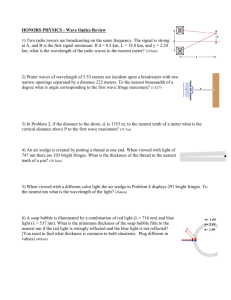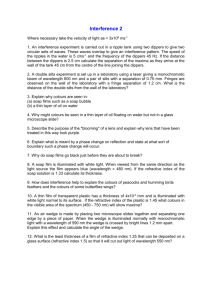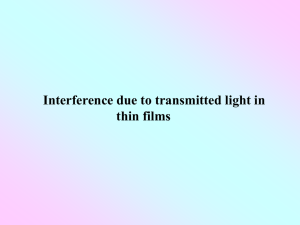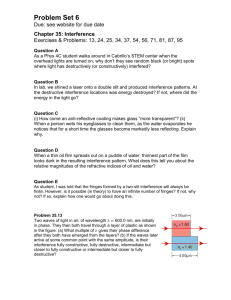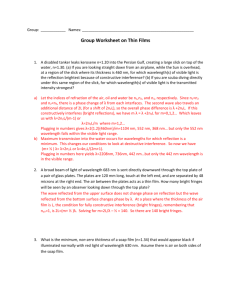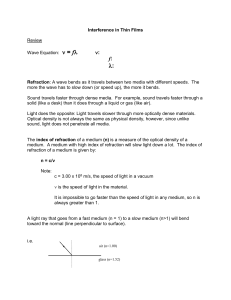Ch 01
advertisement
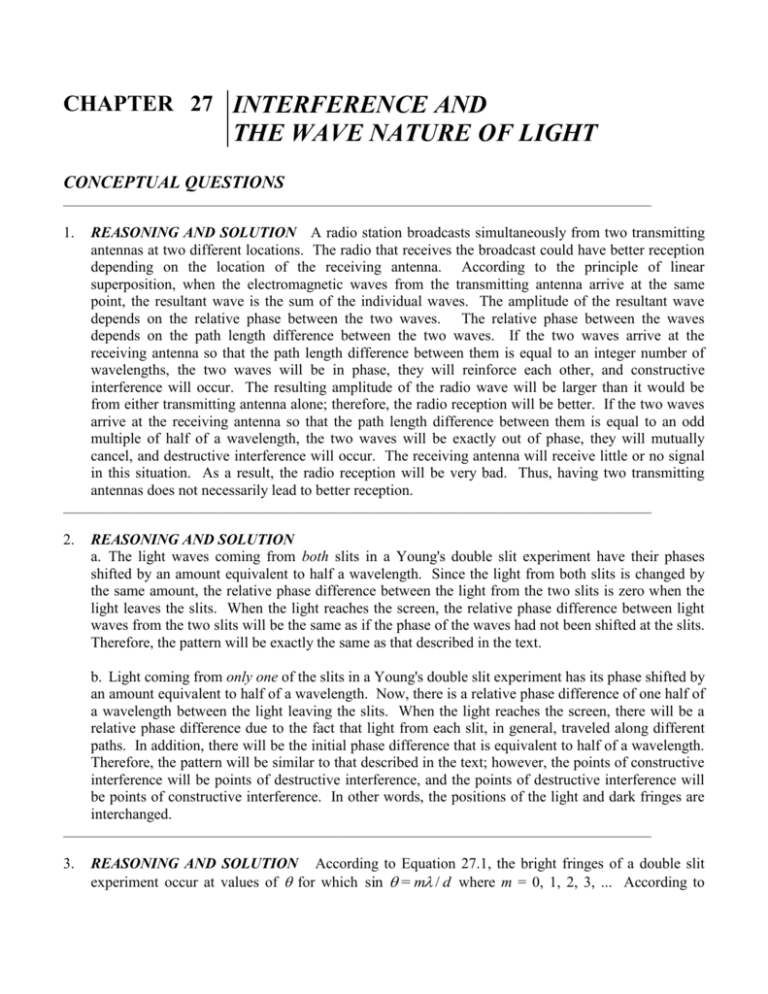
CHAPTER 27 INTERFERENCE AND THE WAVE NATURE OF LIGHT CONCEPTUAL QUESTIONS _____________________________________________________________________________________________ 1. REASONING AND SOLUTION A radio station broadcasts simultaneously from two transmitting antennas at two different locations. The radio that receives the broadcast could have better reception depending on the location of the receiving antenna. According to the principle of linear superposition, when the electromagnetic waves from the transmitting antenna arrive at the same point, the resultant wave is the sum of the individual waves. The amplitude of the resultant wave depends on the relative phase between the two waves. The relative phase between the waves depends on the path length difference between the two waves. If the two waves arrive at the receiving antenna so that the path length difference between them is equal to an integer number of wavelengths, the two waves will be in phase, they will reinforce each other, and constructive interference will occur. The resulting amplitude of the radio wave will be larger than it would be from either transmitting antenna alone; therefore, the radio reception will be better. If the two waves arrive at the receiving antenna so that the path length difference between them is equal to an odd multiple of half of a wavelength, the two waves will be exactly out of phase, they will mutually cancel, and destructive interference will occur. The receiving antenna will receive little or no signal in this situation. As a result, the radio reception will be very bad. Thus, having two transmitting antennas does not necessarily lead to better reception. _____________________________________________________________________________________________ 2. REASONING AND SOLUTION a. The light waves coming from both slits in a Young's double slit experiment have their phases shifted by an amount equivalent to half a wavelength. Since the light from both slits is changed by the same amount, the relative phase difference between the light from the two slits is zero when the light leaves the slits. When the light reaches the screen, the relative phase difference between light waves from the two slits will be the same as if the phase of the waves had not been shifted at the slits. Therefore, the pattern will be exactly the same as that described in the text. b. Light coming from only one of the slits in a Young's double slit experiment has its phase shifted by an amount equivalent to half of a wavelength. Now, there is a relative phase difference of one half of a wavelength between the light leaving the slits. When the light reaches the screen, there will be a relative phase difference due to the fact that light from each slit, in general, traveled along different paths. In addition, there will be the initial phase difference that is equivalent to half of a wavelength. Therefore, the pattern will be similar to that described in the text; however, the points of constructive interference will be points of destructive interference, and the points of destructive interference will be points of constructive interference. In other words, the positions of the light and dark fringes are interchanged. _____________________________________________________________________________________________ 3. REASONING AND SOLUTION According to Equation 27.1, the bright fringes of a double slit experiment occur at values of for which sin = m / d where m = 0, 1, 2, 3, ... According to 158 INTERFERENCE AND THE WAVE NATURE OF LIGHT Equation 27.2, the dark fringes occur at values of for which sin = [m (1/ 2)] / d where m = 0, 1, 2, 3, . . . The slits S1 and S2 in Figure 27.5 are replaced with identical loudspeakers and use the same ac electrical signal to drive them. The two sound waves produced will then be identical, and we have the audio equivalent of Young's double slit experiment. Sound waves that reach the center of the screen have traveled along paths of equal length; therefore, the sound waves from each loudspeaker arrive there in phase and constructive interference occurs. Consequently, at the center point on the screen, the sound will have maximum loudness. As you proceed to walk away from the center (in either direction), the sound will decrease in volume. When the angle is such that sin = (1/ 2) / d , the sound will decrease to zero amplitude. If you continue to walk beyond this point, the loudness of the sound will increase. It will reach a maximum (a point of constructive interference) when the angle is such that sin = /d . The sound will again decrease in loudness until the next point of destructive interference occurs. This point occurs when sin = (3/ 2) / d . In general, there will a pattern of alternating loud and soft sounds heard as you walk away from the center of the screen. The intensity at the points of constructive interference varies in a manner that is similar to that shown in Figure 27.7. The central maximum has the greatest intensity. The sound at each region of constructive interference decreases in intensity as one proceeds away from the center (in either direction). _____________________________________________________________________________________________ 4. REASONING AND SOLUTION The angle for the interference maximum in Young's double-slit experiment is given by Equation 27.1: sin m / d where m = 0, 1, 2, 3, . . . When the wavelength of the light is greater than the distance d between the slits, the ratio / d is greater than one; however, sin cannot be greater than one. Therefore, it is not possible to see interference fringes when the wavelength of the light is greater than the distance between the slits. _____________________________________________________________________________________________ 5. REASONING AND SOLUTION A camera lens is covered with a nonreflective coating that eliminates the reflection of perpendicularly incident green light. If the light were incident on the nonreflective coating at 45°, rather than perpendicularly, it would not be eliminated by the coating and an observer would see it. Following the reasoning of Example 4, part (b), if the refractive index of the film is less than the refractive index of the lens, the minimum nonzero thickness of the nonreflecting coating is given by t coating / 4 . This result follows from the fact that the extra distance traveled by the wave that travels through the coating is 2t when the wave strikes the film at normal incidence. Chapter 27 Conceptual Questions 159 If the wave strikes the thin film at 45°, then air = 45° the extra distance traveled by the wave that travels through the coating is no longer 2t. n1 Instead, it is 2d, where d is the distance shown in the figure at the right. The value of n2 d depends on the value for 2, the angle of d d refraction. This angle, in turn, depends on t the refractive index n1 for air and n2 for the lens coating lens coating, according to Snell's law (Equation 26.2). To eliminate the light that is incident at 45°, the coating would have to have a minimum nonzero thickness such that d coating / 4 . Since the coating is designed such that t coating / 4 , it does not eliminate the light incident at 45°. _____________________________________________________________________________________________ 6. REASONING AND SOLUTION When sunlight reflects from a thin film of soapy water, the film appears multicolored, in part because destructive interference removes different wavelengths from the light reflected at different places, depending on the thickness of the film. As the film becomes thinner and thinner, the path length difference between the light reflected from the top of the film and the light reflected from the bottom of the film becomes closer to zero. The light reflected from the top of the film undergoes a phase change equivalent to half of a wavelength. Therefore, as the thickness of the film approaches zero, the light reflected from the top of the film is almost exactly out of phase with the light reflected from the bottom of the film. Therefore, as the film becomes thinner and thinner, it looks darker and darker in reflected light. It appears black just before it breaks, because at that point destructive interference occurs between the light reflected from the top and the light reflected from the bottom of the film. _____________________________________________________________________________________________ 7. REASONING AND SOLUTION Two pieces of the same glass are covered with thin films of different materials. The thickness t of each film is the same. In reflected sunlight, however, the films have different colors. This could occur because, in general, different materials have different refractive indices. Following the reasoning of Example 4, parts (a) and (b), the wavelength air that is removed from the reflected light corresponds to a value of film in the film that satisfies either of the following conditions: 2t mfilm , and m = 0, 1, 2, 3, . . . 2t m 1 2 film , m = 0, 1, 2, 3, . . . nfilm nglass , (1) nfilm nglass . (2) However, the value of the wavelength film of the light in the film depends on the index of refraction of the film. According to Equation 27.3, film vacuum / n , where n is the index of refraction of the 160 INTERFERENCE AND THE WAVE NATURE OF LIGHT film. If the index of refraction of the two materials are different, then conditions (1) and (2) will be satisfied for two different values of film. These values of film correspond to different values of air, and, therefore, different wavelengths will be removed from the reflected light. _____________________________________________________________________________________________ 8. REASONING AND SOLUTION When a spherical surface is put in contact with an optically flat plate, circular interference patterns, called Newton's rings, can be observed in reflected light, as shown in Figure 27.16b. There is a dark spot at the center of the pattern of Newton's rings. The dark spot occurs for the following reason. At the center of the plate, the spherical surface is in contact with the plate. Destructive interference occurs there, because the thickness of the "air wedge" is essentially zero at this point. Therefore, the only difference in phase between the light reflected from the bottom of the spherical surface and the light reflected from the top of the optical flat is the halfwavelength phase change due to reflection from the optical flat. This situation is similar to that discussed in part (b) of Example 6 in the text. _____________________________________________________________________________________________ 9. REASONING AND SOLUTION A thin film of material is floating on water (n = 1.33). When the material has a refractive index of n = 1.20, the film looks bright in reflected light as its thickness approaches zero. But when the material has a refractive index of n = 1.45, the film looks black in reflected light as its thickness approaches zero. When the material has a refractive index of n = 1.20, both the light reflected from the top of the film and the light reflected from the bottom of the film occur under conditions where light is traveling through a material with a smaller refractive index toward a material with a larger refractive index. Therefore, both the light reflected from the top and the bottom of the film undergoes a phase change upon reflection. Both phase changes are equivalent to half of a wavelength. Therefore, the reflections introduce no net phase difference between the light reflected from the top and bottom of the film. As the thickness of the film approaches zero, the path difference between the light reflected from the top and the bottom of the film approaches zero. Since the path difference is close to zero, and there is no relative phase difference due to reflection, the light reflected from the top will be in phase with the light reflected from the bottom of the film, and constructive interference will occur. Therefore, the film looks bright in reflected light. When the material has a refractive index of n = 1.45, only the light reflected from the top of the film is traveling through a material with lower refractive index toward a material with a larger refractive index. Therefore, only the light reflected from the top undergoes a phase change upon reflection. This phase change is equivalent to half of a wavelength. Therefore, there is a net phase difference equivalent to half of a wavelength between the light reflected from the top and the light reflected from the bottom of the film. As the thickness of the film approaches zero, the path difference between the light reflected from the top and the light reflected from the bottom of the film approaches zero. Since the path difference is close to zero, and there is a relative phase difference due to reflection that is equal to half of a wavelength, the light reflected from the top will be exactly out of phase with the light reflected from the bottom of the film, and destructive interference will occur. Therefore, the film looks black in reflected light. _____________________________________________________________________________________________ 10. REASONING AND SOLUTION A transparent coating is deposited on a glass plate and has a refractive index that is larger than that of the glass. For a certain wavelength within the coating, the Chapter 27 Conceptual Questions 161 thickness of the coating is a quarter wavelength. The coating enhances the reflection of the light corresponding to this wavelength. As discussed in part (a) of Example 4, only the light reflected from the top of the coating is traveling in through a material (air) with lower refractive index toward a material coating with a larger refractive index. Therefore, only the light reflected from the top of the coating undergoes a phase change upon reflection. This change in phase is equivalent to half of a wavelength. Therefore, there is a net phase difference equivalent to half of a wavelength between the light reflected from the top and light reflected from the bottom of the coating. Since the thickness of the coating is a quarter wavelength, the light reflected from the bottom of the coating traverses a distance equal to two times a quarter wavelength, or half a wavelength, as it travels through the coating. The overall relative phase difference between the light reflected from the top and the light reflected from the bottom of the coating is equivalent to half of a wavelength due to the reflection from the top of the coating and another half of a wavelength due to the path difference between the light reflected from the top and the light reflected from the bottom. Thus, the overall phase difference is equivalent to a whole wavelength, and the light reflected from the top is in phase with the light reflected from the bottom. Constructive interference occurs, and the coating enhances light corresponding to that wavelength. _____________________________________________________________________________________________ 11. REASONING AND SOLUTION Rayleigh's criterion states that two point objects are just resolved when the first dark fringe in the diffraction pattern of one falls directly on the central bright fringe in the diffraction pattern of the other. Equation 27.6 approximates the minimum angular displacement between the two objects so that they are just resolved by an optical instrument: min 1.22 / D , where is the wavelength of light used and D is the diameter of the aperture of the optical instrument. According to Equation 27.6, optical instruments with the highest resolution should have the largest possible diameter D and utilize light of the shortest possible wavelength. The f-number setting on a camera gives the ratio of the focal length of the camera lens to the diameter of the aperture through which the light enters the camera. Therefore, smaller f-numbers mean larger aperture diameters. According to Equation 27.6, if we wish to resolve two closely spaced objects in a picture, we should adjust the aperture to have the largest possible diameter. As a result, we should use a small f-number setting. _____________________________________________________________________________________________ 12. REASONING AND SOLUTION According to Equation 27.6, Rayleigh's criterion is satisfied for two point sources viewed through a circular lens when the angular separation min is given by min 1.22 / D , where D is the diameter of the lens and is the wavelength of light as it travels from the lens to the film. Since the camera is watertight, the region between the lens and the film is filled with air, regardless of whether the camera is in air or under water. Thus, the wavelength is the same in both situations, so both give rise to the same resolution. _____________________________________________________________________________________________ 13. REASONING AND SOLUTION As discussed in the text, the extent to which a wave bends or diffracts around the edges of an obstacle or opening is determined by the ratio /W, where is the wavelength of the wave and W is the width of the obstacle or opening. As the ratio /W becomes larger, diffraction effects become more pronounced. 162 INTERFERENCE AND THE WAVE NATURE OF LIGHT The wavelength of light is extremely small and is normally expressed in nanometers (1 nm = 10 –9 m ). Therefore, the ratio /W is very small for light, and when light passes through a typical doorway, diffraction effects are not noticeable. Many sound waves encountered in the everyday world have wavelengths that are comparable to the dimensions of a typical doorway. Therefore, the ratio /W is nearly unity for these sounds, and when sound passes through a doorway, diffraction effects are noticeable; you can hear around corners, although you cannot see around corners. _____________________________________________________________________________________________ 14. REASONING AND SOLUTION Light enters the eye through the pupil. The inner side of the pupil has a refractive index of 1.36. When green light of wavelength vacuum = 550 nm passes through the opening in the pupil, its wavelength is shortened according to Equation 27.3: eye vacuum n 550 nm 404 nm 1.36 Light also passes through a hole in a sheet of opaque material. The hole has the same diameter as the pupil and is surrounded by air. When green light of wavelength vacuum = 550 nm passes through the hole, its wavelength remains the same, since nair is nearly 1. As discussed in the text, the extent to which a wave bends or diffracts around the edges of an obstacle or opening is determined by the ratio /W, where is the wavelength of the wave and W is the width of the obstacle or opening. As the ratio /W becomes larger, diffraction effects become more pronounced. Since air > eye, and W is the same for both the hole and the pupil, the ratio /W is largest for the light that passes through the hole in the opaque material. Therefore, green light will diffract more when it passes through the hole than when it passes through the pupil. _____________________________________________________________________________________________ 15. REASONING AND SOLUTION Four light bulbs are arranged at the corners of a rectangle that is three times longer than it is wide. You look at this arrangement perpendicular to the plane of the rectangle. From very far away, your eyes cannot resolve the individual bulbs and you see a single rectangular "smear" of light. From close in, you see the individual bulbs. The figures below illustrate what you would see at two positions between these two extremes. In the first case, you are still far away, but you have moved close enough so that you can begin to resolve the bulbs at opposite ends of the diagonal. Essentially, you see a rectangular "smear" of light with a gap in the middle. gap In the second case, you have moved closer still and now can resolve the two bulbs on one of the short sides of the rectangle from the two on the other short side. Essentially, you see two "smears" of light, each smear consisting of the two bulbs at the ends of a short side of the rectangle. Chapter 27 Conceptual Questions 163 two bulbs on two bulbs on short side short side _____________________________________________________________________________________________ 16. REASONING AND SOLUTION The resolving power, or the ability to resolve two closely spaced images, through any circular aperture (such as the pupil of your eye) is limited by diffraction effects. The Rayleigh criterion for resolution focuses on these effects and is given by min 1.22 / D (Equation 27.6), where is the wavelength of light, D is the diameter of the aperture, and min is the minimum angle that can be resolved between two point objects by a circular aperture. A smaller value for min or /D means a greater resolving power. a. Suppose the pupil of your eye were elliptical instead of circular in shape, with the long axis of the ellipse oriented in the vertical direction. Since the resolving power depends on the diameter of the aperture and since the ellipse is longer than it is wide, the resolving power of your eye would not be the same in the horizontal and vertical directions. b. If the pupil of your eye were elliptical instead of circular in shape, with the long axis of the ellipse oriented in the vertical direction, the "diameter" or "width" would be larger in the vertical direction and smaller in the horizontal direction. Consider two "planes" of light rays. Plane 1 is oriented so that neighboring rays are horizontal, and plane 2 is oriented so that neighboring rays are stacked vertically. Since the "diameter" of your eye is largest in the vertical direction, the ratio /D is smaller for light in plane 2 than it is for light in plane 1. Thus, diffraction effects will be less noticeable for light rays stacked vertically. Therefore, the resolving power will be greater in the vertical direction. _____________________________________________________________________________________________ 17. REASONING AND SOLUTION Rayleigh's criterion states that two point objects are just resolved when the first dark fringe in the diffraction pattern of one falls directly on the central bright fringe in the diffraction pattern of the other. Equation 27.6 approximates the minimum angular displacement min between the two objects so that they are just resolved by an optical instrument: min 1.22 / D , where is the wavelength of light used and D is the diameter of the aperture of the optical instrument. According to Equation 27.6, optical instruments with the highest resolution should have the largest possible diameter D and utilize light of the shortest possible wavelength. Suppose you were designing an eye and could select the size of the pupil and the wavelength of the electromagnetic waves to which the eye is sensitive. As far as the limitation created by diffraction is concerned, the following list ranks the design choices in order of decreasing resolving power (greatest first): (a) large pupil (large D) and ultraviolet wavelengths (small ); (c) small pupil (small D) and ultraviolet wavelengths (small ); (b) small pupil (small D) and infrared wavelength (larger ). _____________________________________________________________________________________________ 18. REASONING AND SOLUTION In our discussion of single-slit diffraction, we ignored the height of the slit, in effect assuming that the height was much larger than the width. Suppose that the height and width were the same size, so that diffraction occurred in both dimensions. The resulting pattern 164 INTERFERENCE AND THE WAVE NATURE OF LIGHT would change in the following way. The height of the horizontal fringes would be reduced. Furthermore, there would be two sets of fringes. One set would be along the horizontal axis, and the other set would be along the vertical axis. The two sets would share a common central maximum. The intensity of the central maximum will be greatest. The intensity will decrease on either side of the central maximum, in both the horizontal and the vertical directions. The figure below shows the central maximum and the less intense higher order on either side of the central maximum in both dimensions. (continues) _____________________________________________________________________________________________ 19. REASONING AND SOLUTION According to Equation 27.7, the angles that locate principal maxima of a diffraction grating satisfy the condition sin m / d , where m = 0, 1, 2, 3, . . . If the entire interference apparatus of a diffraction grating (light source, grating, and screen) were immersed in water, the wavelength of the light would decrease from the value air to the value water. This is because these values are related by Equation 27.3, water vacuum / nwater air / nwater , where we have used the fact that vacuum and air are nearly the same, since nair is nearly 1. Thus, angles that locate principal maxima of a diffraction grating immersed in water will be smaller than when the apparatus is immersed in air. Consequently, the principle maxima will be closer together when the apparatus is immersed in water relative to their location when the entire apparatus is immersed in air. _____________________________________________________________________________________________
